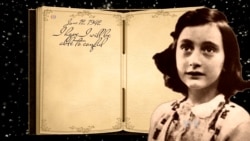“I hope I will be able to confide everything to you, as I have never been able to confide in anyone, and I hope you will be a great source of comfort and support.”
This is the first entry in The Dairy of Anne Frank. She wrote it on June 12, 1942—her 13th birthday. At that moment, she was a normal teenager living with her family in the Netherlands, where they moved from Frankfurt after Hitler’s rise to power. This was one of Anne’s last diary entries as a carefree teenager. Less than a month later, on July 5, 1942, her family was summoned for deportation to the Westerbork concentration camp.
“The entry that Anne made in the diary exactly 75 years ago, and what she wrote in the duration of that entire week—that is the last proof of normal life. Friends, plans, prosperity,” said Edna Friedberg, curator of the National Holocaust Museum in Washington. “Instantly, Anne will be in a nightmare world. She will have to literally disappear, physically disappear.”
She did just that, vanishing into an Amsterdam rowhouse. The canal-facing Opekta Building became a shelter for Anne’s family and a few more Jews. They hid in a 46 square meter room behind a door masked as a bookcase. Here, Anne wrote letters to her imaginary friend Kitty about everything that worried her: her relationship with her parents, her first love, arguments over food, violence in the streets below.
The Holocaust survivor Primo Levi wrote that there is a duty not to understand the Holocaust, “because to understand is to justify.” But, he maintained, “if understanding is impossible, knowing is imperative, because what happened could happen again.” Anne Frank’s account remains a terrifying part of truly “knowing” the Holocaust.
“Often in the evening, in the darkness, I see columns of innocent people walking, driven by a pair of scoundrels, who beat them and torture them until they fall to the ground,” wrote Frank. “They don’t spare anybody: the elderly, children, infants, the sick, pregnant women—everyone goes to face death …It’s a terrible feeling to suddenly be an excess.”
Frank’s diary became one of 35 objects included in the Memory of the World Register, a UNESCO World Heritage List. Currently, the book is translated into 67 languages. Every modern schoolchild knows the Jewish girl’s name.
“This is proof that history isn’t statistics and facts, it’s always the fates of people,” said Friedberg.
Anne wrote her last entry in the diary on August 1, 1944. Everybody who was hiding in the building was found, arrested and sent to a death camp. Anne died in the Bergen-Belsen concentration camp in March of 1945.
“In spite of everything, I still believe that people are really good at heart.”’ Friedman stopped reading and looked up. “That’s my favorite quote from her diary. It’s painful to think that the girl believed in humanity until her last days.”
The 15-year-old girl’s 7-month stay at the camp, punctuated by slave labor, hunger and finally death, hardly confirm her optimistic words. Anne’s father Otto was the only member of the family to survive the Holocaust. He decided to publish the diary as proof that his daughter lived, loved and hoped. Anne became the voice of 6 million Jews—the victims of the Holocaust.
“Just think about how many talented and smart children like that were destroyed,” said Friedman.
One-point-five million Jewish children died during the years of the Holocaust. “Multiply this number by a million,” they say at the Memorial Museum in Washington. The lost life of a child is lost generations. Proof of that is the fate of a girl named Louisa, who was in hiding on the same street as Anne Frank. She survived. Today, 75-year-old Louisa Lawrence lives in Bethesda, Maryland and has three daughters and six grandchildren. Most often today, she has to answer the question: How does she feel about the thought that she was able to survive, but Anne, the girl who lived next door, didn’t?
“I am truly sorry for her,” said Lawrence. “But at the same time I’m thankful that my family was able to survive. I remember when The Diary of Anne Frank was published, everyone was uncomfortable. They didn’t want to talk about it, because it was painful, and embarrassing for others. This diary, written with the truthful words of a young girl, forced the world to hear about the horrors of that time.”
This report originated in VOA's Russian Service.






